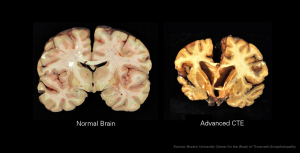Chronic traumatic encephalopathy (CTE) is known by many names, including punch-drunk syndrome and dementia pugilistica (DP), but the definition remains the same. It’s a type of neurodegenerative disease or dementia cause by repeated concussive or sub-concussive blows.
Dr. Harrison Stanford Martland, forensic pathologist, was one of the first to describe the condition in his article “Punch Drunk,” originally published in the October 13, 1928 edition of the Journal of the American Medical Association:
“Fight fans and promoters have recognized a peculiar condition occurring among prize fighters which, in ring parlance, they speak of as ‘punch drunk.’ Fighters in whom the early symptoms are well recognized are said by the fans to be ‘cuckoo,’ ‘goofy,’ ‘cutting paper dolls’ or ‘slug nutty.’ Frequently it takes a fighter from one to two hours to recover from a severe blow to the head or jaw.”
While boxing gave the condition a name, football players experienced similar injuries. In 1893, U.S. Naval Academy Midshipman and football player Joseph M. Reeves received a warning from a navy doctor stating that another hit to the head could cause “instant insanity” or death. Desiring to play in the Army-Navy game, Reeves commissioned a local shoemaker to create what is now considered the first football helmet to avoid further injury. The rudimentary helmet kept him alive, allowing him to become the Father of Carrier Aviation, Admiral “Bull” Reeves.
Twenty years later, football coach Glenn “Pop” Warner commented he had “many times seen cases when hard bumps on the head so dazed the player receiving them that he lost memory got a time and had to be removed from the game.”
The medical community began to take notice of the damaging effects of repeated concussions, causing a decline in physical, emotional and mental health. The following list reflects some of the long-standing knowledge surrounding the debilitating effects of CTE and dementia:
1930s
- Millspaugh, J. A. “Dementia Pugilistica.” U.S. Naval Medicine Bulletin (1937) 35, pp. 297-303.
- Busse, EW, Silverman, AJ.”Electroencephalographic Changes in Professional Boxers.” Journal of the American Medical Association (1952) 149(17):1522-1525.
1950s
- Strich S “Diffuse Degeneration of the Cerebral white matter in severe dementia following head injury.” Journal of Neurology, Neurosurgery and Psychiatry (1956) August; 19(3): 163–185.
- Corsellis JAN, Brierley JB. “Observations on the Pathology of Insidious Dementia Following Head Injury” Journal of Mental Science (1959) 105: 714-720.
1960s
- Fisher CM. “Concussion amnesia.” Neurology (1966) 16:826-830.
- Payne, EE. “Brains of boxers” Neurochirurgia (1968) Sep;11(5):173-88.
- John Johnson M.D., M.R.C.P.E., D.P.M. “Organic Psychosyndromes due to Boxing.” The British Journal of Psychiatry (1969) 115: 45-53.
- Roberts, Anthony Herbers. Brain Damage in Boxers: A study of the prevalence of traumatic encephalopathy among ex-professional boxers. London: Pitman Medical & Scientific Publishing Co., Ltd., 1969.
1970s
- Yarnell PR, Lynch S. “Retrograde Memory Immediately After Concussion.” The Lancet (1970) 295(7652):863-864.
- In 1973, a disabling and sometimes deadly condition involving the second impact concussion occurring before symptoms of a first concussion was described by R.C. Schneider. This later was coined the Second Impact Syndrome in 1984.
- Corsellis JA, Bruton CJ, Freeman-Browne D. “The Aftermath of Boxing.” Psychology Medicine (1973) Aug;3(3):270-303.
- Ommaya AK, Gennarelli TA. “Cerebral Concussion and Traumatic Unconsciousness: Correlation of experimental and clinical observations of blunt head injuries.” Brain (1974) 97: 633-654
- Harvey PK, Davis JN. “Traumatic Encephalopathy in a Young Boxer.” Lancet (1974) Oct 19;2(7886):928-9.
- Gronwall D, Wrightson P.”Delayed Recovery of Intellectual Function After Minor Head Injury.” Lancet (1974) Sep 14;2(7881):605-9.
- Gronwall D, Wrightson P. “Cumulative Effect of Concussion” Lancet (1975) 306 (7943): 995-997.
- Corsellis, JAN. “Posttraumatic dementia.” Aging (1978) 7:125-133.
1980s
- Tysvaer A, Storli O. Association Football Injuries to the Brain: a preliminary report.” British Journal of Sports Medicine (1981) 15:163-166.
